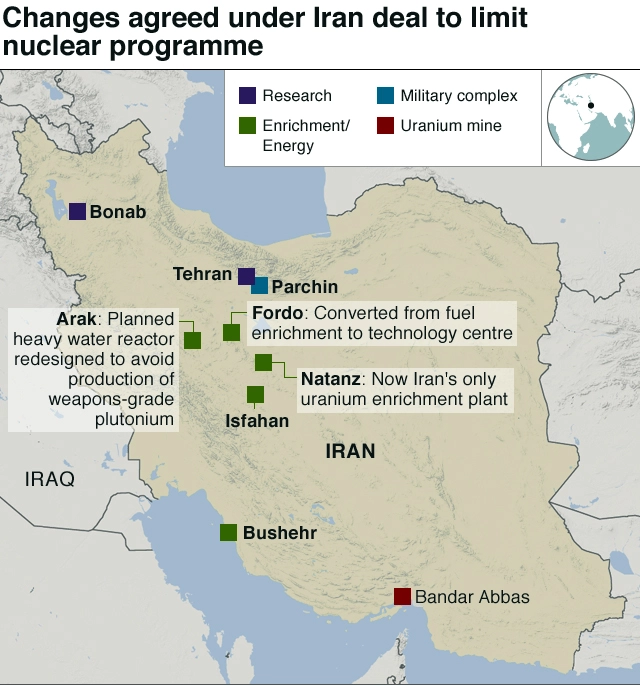International Relations
Iran Nuclear Deal
- 05 Mar 2022
- 7 min read
For Prelims: Joint Comprehensive Plan of Action, Iran and the surrounding countries.
For Mains: Groupings & Agreements Involving India and/or Affecting India's Interests, JCPOA and its Significance.
Why in News?
Recently, the diplomats from Iran and world powers reconvened in Vienna (Austria) to seek a deal reviving Iran’s (Tehran’s) 2015 Nuclear Accord.
- The 2015 Iran nuclear deal, signed under President Barack Obama, and dismantled in 2018 by President Donald Trump.
- The US said it will rejoin the agreement if Iran complies with the terms of the original deal, and if it addresses other issues related to alleged ballistic missile stockpiles and the proxy conflicts that it backs across the region.
What was the 2015 Iran nuclear deal?
- The deal, formally known as Joint Comprehensive Plan of Action (JCPOA).
- The JCPOA was the result of prolonged negotiations from 2013 and 2015 between Iran and P5+1 (China, France, Russia, the United Kingdom, the United States + Germany).
- Under the deal, Iran agreed to significantly cut its stores of centrifuges, enriched uranium and heavy-water, all key components for nuclear weapons.
- Iran also agreed to implement a protocol that would allow inspectors from the International Atomic Energy Agency (IAEA) to access its nuclear sites to ensure Iran would not be able to develop nuclear weapons in secret.
- While the West agreed to lift sanctions related to Iran’s nuclear proliferation, other sanctions addressing alleged abuses of human rights and Iran’s ballistic missile programme remained in place.
- The US committed to lifting sanctions on oil exports, but continued to restrict financial transactions, which have deterred international trade with Iran.
- Nonetheless, Iran’s economy, after suffering years of recessions, currency depreciation, and inflation, stabilized significantly after the deal took effect, and its exports skyrocketed.
- Israel, America’s closest ally in the Middle East, strongly rejected the deal, and other countries like Iran’s great regional rival Saudi Arabia, complained that they were not involved in the negotiations even though Iran’s nuclear programme posed security risks for every country in the region.
- After Trump abandoned the deal and reinstated banking and oil sanctions, Iran ramped up its nuclear programme in earnest, returning to approximately 97% of its pre-2015 nuclear capabilities.
What happened after the US pulled out of the deal?
- In April 2020 the US announced its intention to snap back sanctions. However, the other partners objected to the move, stating that since the US was no longer part of the deal, it could not unilaterally reimpose sanctions.
- Initially following the withdrawal, several countries continued to import Iranian oil under waivers granted by the Trump administration. A year later, the US ended the waivers to much international criticism and, by doing so, significantly curbed Iran’s oil exports.
- The other powers, in an attempt to keep the deal alive, launched a barter system known as INSTEX to facilitate transactions with Iran outside the US banking system. However, INSTEX only covered food and medicine, which were already exempt from US sanctions.
- In January 2020, after the US assassinated the top Iranian general Qasem Soleimani, Iran announced that it would no longer limit its uranium enrichment.
What are the Challenges to the Restoration of JCPOA?
- The regional cold war between Saudi Arabia and Iran is a major hurdle to the restoration.
- The US and Saudi Arabia have strengthened their relationship per US’s Middle East policy and to counter Iran as well.
- The traditional Shia vs Sunni conflict between these countries has made it difficult to negotiate peace in the region.
- Iran is currently in violation of several of its important commitments, such as the limits on stockpiles of enriched uranium, and the farther it goes, the more challenging the deal becomes.
- Iran is blaming US sanctions for its economic losses due to the Trump administration’s pullout from the deal and imposing sanctions again.
What is the Significance of JCPOA for India?
- Boost to Regional Connectivity:
- Removing sanctions may revive India’s interest in the Chabahar port, Bandar Abbas port, and other plans for regional connectivity.
- This would further help India to neutralize the Chinese presence in Gwadar port, Pakistan.
- Apart from Chabahar, India’s interest in the International North-South Transit Corridor (INSTC), which runs through Iran, which will improve connectivity with five Central Asian republics, may also get a boost.
- Energy Security:
- Due to the pressure linked to the US’ Countering America’s Adversaries Through Sanctions Act (CAATSA), India has to bring down oil imports to zero.
- Restoration of ties between the US and Iran will help India to procure cheap Iranian oil and aid in energy security.
Way Forward
- The US would have to factor in not only Iran’s nuclear programme but also its increasingly hostile behavior in the region. It would also have to take into consideration the reality of the new multipolar world, in which its unilateral leadership is no longer guaranteed.
- Iran would have to consider the rapidly changing dynamics in the Middle East, given that Israel has recalibrated its relations with several Middle Eastern Arab countries in recent years.





